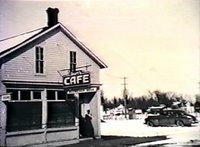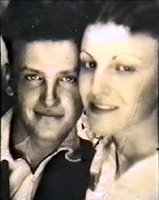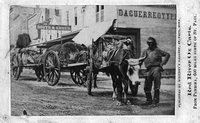

The Gooselaw family were one one of the earliest to settle St. Vincent, as the article in these two scans explain. Be sure and read about their family as told to the local school's annual, Borderlines many years ago, at left.
One of the Gooselaws mentioned in the article - Louis - grew up to be a barber in Pembina across the river. My Dad at one time had his hair cut regularly by Louis. Louis' shop was a real old-time barber shop complete with the red and white cylinder out front, smoking inside, and lots of calendars and magazines laying around. No one was in a real hurry, and while no men would admit it, a lot of gossip flew around in there! A few times I hung out in the waiting area while my Dad got a quick trim...
When I was growing up, Eli Gooselaw lived across the east field from our place, just north of the St. Vincent cemetery. I'm not sure who brought it up first - I think it was me, as a child, mentioning it to my mother - but between my Mom and I, we always joked how Eli's house looked haunted at night. There was this one particular pane of window glass in his upstairs that always looked hazy like a light was on, but not quite, even on overcast nights. It's hard to explain now, it's one of those things you'd have to see for yourself.
Another thing that gave Eli's place extra atmosphere was his teepee. It wasn't an actual teepee like the native Indians used to live in, but rather a tall teepee-shaped vertical stack of wood, most likely old telephone poles and such, that Eli kept by his house. We speculated he used it for firewood.
Eventually, Eli passed away, and so did his house - it was pulled down to make room for the St. Vincent dike. The tall, weather-beaten house with no paint, creepy windows, and its teepee, was no more, now only memories.









